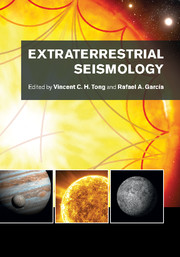Book contents
- Frontmatter
- Contents
- List of contributors
- Preface
- Acknowledgements
- List of abbreviations
- Planetary seismology: High risk, high return
- A bright outlook for helio- and asteroseismology
- Part I Observation and space missions
- Part II Data and physical parameters
- Part III Modeling approaches
- Part IV Discoveries of physical structures and processes
- Part V Interdisciplinary research involving planetary and astrophysical sciences
- 16 Diskoseismology of accretion disks
- 17 Numerical simulations of magnetoconvection and helioseismology
- 18 Impact seismology on terrestrial and giant planets
- 19 Angular momentum transport in stars: From short to long time scales
- 20 From the Sun to the distant stars, and back: Future research directions
- 21 Stellar dynamics: Rotation, convection, and magnetic fields
- 22 Sunquakes: Helioseismic response to solar flares
- 23 Seismic waves in small bodies: Sources and propagation
- Part VI Interdisciplinary research involving terrestrial seismology
- References
- Index
16 - Diskoseismology of accretion disks
from Part V - Interdisciplinary research involving planetary and astrophysical sciences
Published online by Cambridge University Press: 05 July 2015
- Frontmatter
- Contents
- List of contributors
- Preface
- Acknowledgements
- List of abbreviations
- Planetary seismology: High risk, high return
- A bright outlook for helio- and asteroseismology
- Part I Observation and space missions
- Part II Data and physical parameters
- Part III Modeling approaches
- Part IV Discoveries of physical structures and processes
- Part V Interdisciplinary research involving planetary and astrophysical sciences
- 16 Diskoseismology of accretion disks
- 17 Numerical simulations of magnetoconvection and helioseismology
- 18 Impact seismology on terrestrial and giant planets
- 19 Angular momentum transport in stars: From short to long time scales
- 20 From the Sun to the distant stars, and back: Future research directions
- 21 Stellar dynamics: Rotation, convection, and magnetic fields
- 22 Sunquakes: Helioseismic response to solar flares
- 23 Seismic waves in small bodies: Sources and propagation
- Part VI Interdisciplinary research involving terrestrial seismology
- References
- Index
Summary
Introduction
In this chapter we describe the recent field of diskoseismology: the study of extraterrestrial seismology in accretion disks. Accretion disks, formed by accumulation of matter falling toward a gravitating object, are ubiquitous in the universe, surrounding a wide variety of celestial objects.
They are a key ingredient in binary systems which host compact objects orbiting a so-called companion star, and attracting matter from it. In these objects, an accretion disk forms through accumulation of gas coming from the companion star, tidally attracted and passing through the inner L1 Lagrange point (see Figure 16.1). The compact object can be either a neutron star or a stellar-mass black hole (these systems are then called compact X-ray binaries, XRBs), or a white dwarf (systems called cataclysmic variables, CVs). Furthermore, they surround the supermassive black holes (SMBH) at the heart of active galaxies, we also detect them at cosmological distances in the extremely energetic gammaray bursts (GRBs), and finally, we find them around protostellar and young stellar objects (YSOs).
From the discovery of the first extra-solar X-ray source – Sco X-1, an XRB in the constellation of Scorpius – reported on December 1, 1962 by Giacconi et al. (1962), to the measurement of quasi-periodic oscillations and broad lines in accretion disks surrounding compact objects, our knowledge of accretion disks has greatly improved, ultimately leading to potential tests of general relativity, due to high gravitational forces naturally created by the presence of compact objects. Putting together these observations, simulations, and predictions, will eventually lead to unique results based on general relativity.
We will show in Section 16.2 that accretion disks are ubiquitous in the celestial objects of our universe, before reviewing in Section 16.3 the general characteristics of accretion disks. We will then introduce in Section 16.4 the field of diskoseismology, reporting the existing observations, numerical simulations, and theoretical predictions of the models, concerning the various celestial objects hosting accretion disks, before concluding in Section 16.5.
- Type
- Chapter
- Information
- Extraterrestrial Seismology , pp. 227 - 237Publisher: Cambridge University PressPrint publication year: 2015



